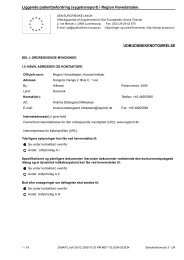Territorial Review Copenhagen - Region Hovedstaden
Territorial Review Copenhagen - Region Hovedstaden
Territorial Review Copenhagen - Region Hovedstaden
You also want an ePaper? Increase the reach of your titles
YUMPU automatically turns print PDFs into web optimized ePapers that Google loves.
178<br />
them from implementing more progressive designs. This is especially the<br />
case for developers that shy away from designs that use geo-thermal heating,<br />
green roofs, recycled water and more environmental ventilation systems.<br />
Given the old housing stock in the <strong>Copenhagen</strong> metropolitan region,<br />
resources are also needed for renovating and retrofitting mixed-income<br />
housing with state-of-the-art environmental and energy design features,<br />
especially weatherisation improvements. Municipalities in the <strong>Copenhagen</strong><br />
metropolitan region might consider requiring insulation tests for<br />
rehabilitated stock, which are obligatory for new homes in the United<br />
Kingdom (Energy Savings Trust, 2007). Finally, local governments could<br />
mandate that new social housing upgrade its environmental criteria by<br />
requiring social housing to abide by high green-building standards. Boston,<br />
for example, greened its affordable housing programme by requiring that<br />
any affordable housing development that receives government support is<br />
certifiable at the ―silver‖ level by the US Green Building Council‘s<br />
Leadership in Energy and Environmental Design (LEED) program. To assist<br />
developers, Massachusetts has offered funding to help developers comply<br />
with these standards. Through a similar initiative, municipalities could<br />
showcase their environmental commitment through affordable housing<br />
development.<br />
Future challenges for the <strong>Copenhagen</strong> metropolitan region<br />
<strong>Copenhagen</strong>‘s population will grow in the next few years. The Øresund<br />
<strong>Region</strong> forecasts predict a growth of 152 000 people in the Swedish side and<br />
75 000 people in the Danish side by 2020 (Statistics Denmark, 2008; <strong>Region</strong><br />
Skåne, 2007). If the <strong>Copenhagen</strong> metropolitan region is to remain a diverse<br />
area with homes for everyone, there will be a need for changes in legislation<br />
that will allow the city to facilitate the development of new housing. Urban<br />
renewal will be critical given the mandate to renovate and modernise the<br />
city‘s old housing stock. The social division of the city will continue to be<br />
one of the greatest challenges faced by the region. Its resolution will require<br />
changes in legislation that will allow the municipalities in the Capital<br />
<strong>Region</strong> to better assist socially disadvantaged groups and distressed<br />
neighborhoods.<br />
2.7.2 Environmental policy and sustainability initiatives<br />
<strong>Copenhagen</strong>‘s environmental policy has solidified its reputation as one<br />
of the ―greenest‖ cities in the world. Since 1990, <strong>Copenhagen</strong>ers have<br />
reduced their CO 2 emissions by 25%, primarily as a result of the operation<br />
of the use of cleaner fuels and the efficiency of its district heating system.<br />
Equally impressive, 90% of building waste is reused and 34% of

















